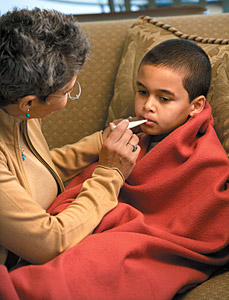Anything that suggest the slightest thing is wrong with a child will cause concern in a parent. A fever, for example, is one of the primary reasons parents will call their child's pediatrician.
Fever 101: What Parents Need to Know
Simply put, our body's first line of defense when invaded by any microbe, virus or bacteria are cells called microphages; a strong, healthy immune system may be able to eliminate the problem with this first step alone. If these fail to contain the microbe/"bug," then the body creates other pryogens and proteins to try to assist. Once these have been created, the hypothalamus in the brain recognizes there is an invader and raises the body temperature to assist in killing it off.
This elevated temperature will generally be just a couple of degrees, but the hypothalamus determines, based on the number of pryogens and proteins, what will be necessary to eliminate the microbe/bug. If the hypothalamus creates additional biochemicals to try to protect the body, then the temperature rises accordingly.1
Defining a Fever
 For all children above the age of 3 months, a fever is actually a good thing.2-3 It's a sign that their immune system is functioning properly. Although many parents will panic when their child has a temperature above 98.6° F (37° C), and this is understandable since many health care providers have called this a "low-grade fever," the reality is that children's temperature may naturally run a little higher than what many consider the norm.
For all children above the age of 3 months, a fever is actually a good thing.2-3 It's a sign that their immune system is functioning properly. Although many parents will panic when their child has a temperature above 98.6° F (37° C), and this is understandable since many health care providers have called this a "low-grade fever," the reality is that children's temperature may naturally run a little higher than what many consider the norm.
A true low-grade fever is anything between 100° F and 102.2° F (37.8° C and 39° C). This level of fever is beneficial; with most microbes/"bugs" that a child will be exposed to, this fever will assist the body in repelling the invader.2-3
A moderate-grade fever is typically between 102.2° F and 104.5° F (39° C and 40° C). This temperature is still considered beneficial; if a child's body has reached this temperature, it's what's needed to kill whatever bacteria or virus their body is attempting to fight.2-3
A high fever is a fever greater than 104.5° F (40° C). This fever may cause the child some discomfort and result in a bit of crankiness. Generally indicative of a bacterial infection, this fever means that the body is fighting something a little more serious than the common cold. While it will not cause brain damage or any other harm to a child, it is wise to seek assistance from their medical provider.2-3
A serious fever is one that is at or above 108° F (42° C); this fever can be harmful.2-3
Can a Fever Be Dangerous?
Fevers that are caused by the body's immune system are not dangerous, and the hypothalamus will control the body temperature and not allow it to get so high as to cause harm. While it can be frightening to have a child running a moderate to high fever, it is simply their body doing what it was designed to do.
The only body temperature that can actually cause brain damage, despite what many parents believe, is 108° F (42° C), and this body temperature cannot typically be achieved on its own, but requires extreme external environmental temperatures – for instance, if a child is left in a closed car in hot weather.2
What About Fever Reducers?
Since it is a very rare fever that can actually cause any kind of harm to a child, the best response is to let it run its course; most fevers will resolve themselves in 24 to 72 hours. Parents should be aware that fevers will naturally spike a little in the late afternoon and evening, so a slight increase in temperature during these times is not a cause for alarm. A wait-and-watch approach should be recommended, rather than turning to over-the-counter chemicals. As Dr. Perri Klass says, "Too small a dose of an antipyretic (fever medicine) may be ineffective; too much can be toxic." The risks associated with these chemicals far outweigh any potential danger from the fever.4-5
The typical over-the-counter drug is going to contain acetaminophen, which may cause liver damage. Other fever reducers include ibuprofen, which can cause stomach upset, and aspirin has been associated with Reye's syndrome when given to children under the age of 19.4
The American Academy of Pediatrics (AAP) does not recommend fever-reducing drugs: "Fever is not an illness, rather, it is a symptom of sickness and is usually a positive sign that the body is fighting infection." Even in cases of high temperatures, the AAP says, "Fevers generally do not need to be treated with medication unless your child is uncomfortable or has a history of febrile convulsions. The fever may be important in helping your child fight the infection."6
The Best Response
The best response to a fever below 104.5° F (40° C) for children over the age of 3 years is lots of rest and clear fluids. Since fevers may cause the child to sweat, parents need to be aware that they will lose sodium and water, which must be replaced with proper fluids. (This does not include Gatorade or other sugary sports drinks.)1 Parents should contact the child's health care provider right away if any of the following occur:1
- A child younger than 3 months is running any grade of fever.
- A child between 3 months and 3 years has a temperature above 102.2° F (39° C) and appears ill (it should be noted that even teething may cause a slight increase in temperature).
- A child of any age has a temperature over 104.5° F (40° C).
Additionally, since dehydration is a potential side effect of fever, encourage parents to watch their child for the following: dry mouth, lack of urine or wet diapers for 6-8 hours (or only a small amount of really dark urine), dry skin, lethargy, irritability, fatigue, or with an older child, dizziness. These signs of dehydration may be a concern and the child should be seen by a health care professional, especially if they are unable to keep down clear fluids.
It is important to note that in children under the age of 5 years, a fever can also lead to a seizure, known as a febrile seizure. However, while this can be frightening, it will typically have no lasting effects.5
"Fever Phobia"
In 1980, Dr. Barton Schmitt published a now-classic article in which he coined the phrase "fever phobia." Many parents believed that untreated fevers could actually rise to critical levels and that even low-grade fevers could have serious neurological effects. This is just not true.5
In 2001, Dr. Michael Crocetti, an assistant professor at Johns Hopkins, was the lead author of a study called "Fever Phobia Revisited: Have Parental Misconceptions About Fever Changed in 20 Years?" He found that 20 years later, not much had changed and that despite education, parents still believe that fevers are dangerous. Keep in mind that although they do increase the need for fluids, fevers in and of themselves are not harmful.5
A fever is a natural part of a child's immune response. When it is functioning at its absolute best, a child's body will fight off most foreign invaders so swiftly that they will have no outward effect at all. However, when necessary, a child's immune system will raise their temperature to create a hostile environment for that invader. It's how a properly functioning body functions.
References
- Mercola J. "Fever: Ally or Enemy?" Jan. 5, 2005.
- Pediatric Advisor 2009.1: Fever Myths and Facts. University of Michigan Health System.
- Pediatric Advisor 2011.1: Fever Myths and Facts. Children's Physicians Network
- Yin HS, et al. Evaluation of consistency in dosing directions and measuring devices for pediatric nonprescription liquid medications. JAMA, Nov. 30, 2010;304(23):2595-2602.
- Klass, P. "Lifting a Veil of Fear to See a Few Benefits of Fever." New York Times, Jan. 10, 2011.
- Crocetti M, et al. "Fever Phobia Revisited: Have Parental Misconceptions About Fever Changed in 20 Years?" Pediatrics, June 2001;107(6):1241-1246.
Click here for previous articles by Claudia Anrig, DC.





